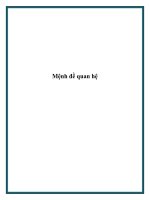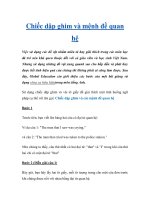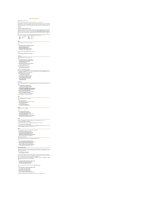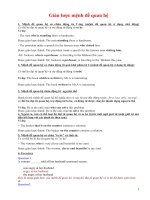slie mệnh đề quan hệ
Bạn đang xem bản rút gọn của tài liệu. Xem và tải ngay bản đầy đủ của tài liệu tại đây (483.08 KB, 23 trang )
HELLO MY
CLASS
Team five: NTP
RELATIVE CLAUSE
I. Introducing Relative Clauses
II. The Relative Pronouns
III. The Relative Adverbs
IV. Exercises Strenghening
V. Mini Game
RELATIVE CLAUSE
I. Introducing relative
clauses.
Ex: The man who is the best handsome of
class B8-D4 is BinhNam.
We use relative clauses to give
more information about something,
without having to start a new
sentence.
We use Relative pronouns and Relative
adverbs in Relative clauses.
RELATIVE CLAUSE
II. Relative pronouns
Relative
pronouns
WHO
WHOM
THAT
WHOSE
WHICH
Definition: The relative pronoun is the subject of the
clause. . We use relative pronouns to introduce relative
clauses, which tell us more about people and things. We use
who and whom for people, and which for things. We use
that for people or things.
RELATIVE CLAUSE
II. Relative pronouns
FUNCTIONS
1
Relative
clause
works as
a subject
2
Relative
clause
works
as an
object
3
Whose:
works as
an
adjective
4
Using
“that”
RELATIVE CLAUSE
II. Relative pronouns
FUNCTIONS
1. Relative clause works as a subject
N(people)+ who + V…….
N(things) + which + V…..
Ex:
- The girl who sits next to me is Lan.
- The book which is on the table is a comedy.
Note:
- The girl who [she] sits next to me is
Lan.
We do not repeat the subject
RELATIVE CLAUSE
II. Relative pronouns
FUNCTIONS
2. Relative clause works as an object
N(people)+ whom + S + V…..
N(things)+ which + S + V……
Ex:
- The girl whom I see is Lan
- The book which I like best is on the table.
Note: When the relative pronoun is object we
sometimes leave it out.
Ex: - The girl I see is Lan. ( we leave “whom” out)
- The book I like best is on the table. (we leave
“which” out)
RELATIVE CLAUSE
II. Relative pronouns
FUNCTIONS
3. Whose: works as an adjective
N(people/things) + whose + N + (S) + V…
Ex:
- This is Hoa whose father is an poet.
- The dog whose hair is white looks
like a little sheep.
RELATIVE CLAUSE
4. USING “THAT”
who/that
1. The girl….........sits
next to me is Lan.
2. The book which/that
………. .is on the table is a
comedy.
3. The girl.whom/that
………. .I see is Lan.
that are sitting there
4.The boy and his dog …….
walk around this park everyday.
that I heard of it.
5. IT was the first time …….
RELATIVE CLAUSE
4. USING “THAT”
“That” can replace for
“who,whom, which” in definite
clause.
Don’t use “that” after a comma(,) or
preposition
1
2
We must use “that” after
3 superlative
We must use “that” after on/only/
4 some+one/body/thing...,the first,…
5 “That” can be used for mixed subject
RELATIVE CLAUSE
RELATIVE CLAUSE
III. Relative adverbs
WHERE
WHEN
WHY
The relative adverbs where, when & why
can be used to join sentences or clauses.
They replace the more formal structure of
preposition + which used to introduce a
relative clause.
RELATIVE CLAUSE
III. Relative adverbs
Where(=in/on/at which): replaces
for the places
WHERE
N(places)+where+S+V…=N(places)+in/on/at which
+S+V…
Ex:
I like to live in a country where there is plenty
of sunshine.
= I like to live in a country in which
there is plenty of sunshine.
RELATIVE CLAUSE
III. Relative adverbs
When(=in/on/at which): replaces for the
time
N(time)+when+S +V…= N(time) +in/on/at which
+ S + V…..
Ex: Do you remember the day
WHEN
when we first met ?
= Do you remember the day on which we
first met?
RELATIVE CLAUSE
III. Relative adverbs
Why(=for which): replaces for
reasons
N(reasons)+why+S+V…=N(reasons)+for which+S
+V…
Ex: Tell me the reason why you are so
sad.
WHY
=Tell me the reason for which you
are so sad.
RELATIVE CLAUSE
IV. Exercises
Strenghening
which
1. There’s a film on to night
……. I really
want to see.
where ……
2. Do you know any restaurants
they serve vegetarian dishes?
who
3. Can you remember………
told you
about the new nightclub?
which
4. The films,
…….. stars Tom Hank, is
basedon a book by Dan Brown.
whose
5. I’ve never met anyone before
………..
mother was famous!
6. Lorenzo,who
…….. is from spain originally,
have lived here for about ten years.
that
7. I saw men, women, cats, and
dogs …..
moved around and around
RELATIVE CLAUSE
IV. Exercises
Strenghening
Choose the word that best completes the sentence:
1. West Side Story is a musical ….
A. That is very famous
B.
B. Which is very famous
C. Where is very famous
D. When is very famous
4. This is the time of the year
…. many people suffer from
hayfever.
A.
A. When
B. Where
2. Antony is a friend of mine ….
C. Which
A.
A. Who live in Boston
B. Whose live in Boston
C. Which live in Boston
D. That live in Boston
3. An actress is a woman …. plays
in films or theatre plays.
D. That
A. Who
A.
B. What
C. Whose
D. That
5. This is the girl …. mother
is from Canada.
A. Who
B.
B. Whose
C. Which
D. When
RELATIVE CLAUSE
IV. Exercises
Strenghening
Rewrite as one sentence using a relative
clause.
1. Here is the book . It is on wild animals.
→ Here is the book which/that is on wild animals.
2.This CD is scratched. I only bought it yesterday.
→ This CD which I only bought yesterday is scratched.
3.The man is my teacher . He is standing over there.
→ The man who is standing over there is my teacher.
4. My sister loves wearing hats. Her hair is brown.
→ My sister whose hair is brown loves wearing hats.
RELATIVE CLAUSE
5. The long table is for reading. It is in the middle of the
room.
the long table which/that is in the middle of the
room is for reading.
6. The books are for reference. They are on the stacks
near the librarian.
the books which/that are on the the stacks are for
reference.
7. We saw the reader . The reader was reading a
newspaper.
we saw the reader who/that was reading a newspaper.
8. I met a man . His sister works in television
I met a man whose sister works in television.
RELATIVE CLAUSE
Một số lưu ý trong mệnh đề quan hệ
1. Nếu trong mệnh đề quan hệ có giới từ thì giới từ có thể đặt trước hoặc
sau mệnh đề quan hệ (chỉ áp dụng với whom và which.)
Ex: Mr. Brown is a nice teacher. We studied with him last year.
o → Mr. Brown, with whom we studied last year, is a nice teacher.
o → Mr. Brown, whom we studied with last year, is a nice teacher.
2. Có thể dùng which thay cho cả mệnh đề đứng trước.
Ex: She can’t come to my birthday party. That makes me sad. → She
can’t come to my birthday party, which makes me sad.
3. Ở vị trí túc từ, whom có thể được thay bằng who.
Ex: I’d like to talk to the man whom / who I met at your birthday party.
4. Trong mệnh đề quan hệ xác định , chúng ta có thể bỏ các đại từ quan
hệ làm túc từ:whom, which.
Ex: The girl you met yesterday is my close friend. The book you lent
me was very interesting.
5. Các cụm từ chỉ số lượng some of, both of, all of, neither of, many of,
none of … có thể được dùng trước whom, which và whose.
Ex: I have two sisters, both of whom are students. She tried on three
dresses, none of which fitted her.
Một số lưu ý trong mệnh đề quan hệ
CÁC TRƯỜNG HỢP DÙNG THAT
Danh từ phía trước chỉ cả người lẫn vật (hỗn
từ)
Ex: I see the girl anh her dog that are running
in the park.
Sau cấu trúc so sánh nhất:
The most
The best & adj + est… + THAT + . . .
The lest
CÁC TRƯỜNG HỢP KHÔNG DÙNG
THAT
Trong mệnh đề quan hệ không xác định
(có dấu phẩy)
Không dùng That khi có giới từ ở phía
trước (in, on, at, of,…)
Sau các từ chỉ số thứ tự:
The first, The second, The third, the last, the
only,…
Không dùng That khi nó thay thế cho cả
mệnh đề đứng trước, mà dùng Which để
thay thế.
Ex: It rained all day, which was a pity.
Sau các đại từ bất định:
Someone, anybody, nothing, any thing,
something, noone,…
Và sau các đại từ:
“all, much, any, few, some, little, none”
Không dùng That với các từ chỉ lượng có
giới từ đi kèm
(neither of, most of, all of, none of, many
of, a lot of,…)
Thank’s!









